Circular Economy: Analyzing Recycling Operations in Manufacturing
VerifiedAdded on 2023/01/12
|15
|3731
|97
Report
AI Summary
This report delves into the concept of the circular economy, emphasizing its aims to redefine growth by prioritizing societal benefits and decoupling economic activity from resource consumption. It explores the transition towards renewable resources and the building of economic, political, and social capitals. The report examines the importance of rethinking and redesigning product development to foster creativity and innovation, particularly in the context of government, institutions, and companies striving to lower carbon emissions. The report analyzes recycling operations within manufacturing companies, using Toyota as a case study, to determine the effectiveness of recycling processes. The report addresses the benefits and challenges of transitioning to a circular economy, including waste reduction, resource efficiency, and the development of sustainable business practices. It also discusses the role of industry 4.0 in enabling the circular economy and the importance of innovative approaches, business models, and partnerships for achieving its goals. The literature review covers the concept of circular economy and its implications on social and economic dynamics.
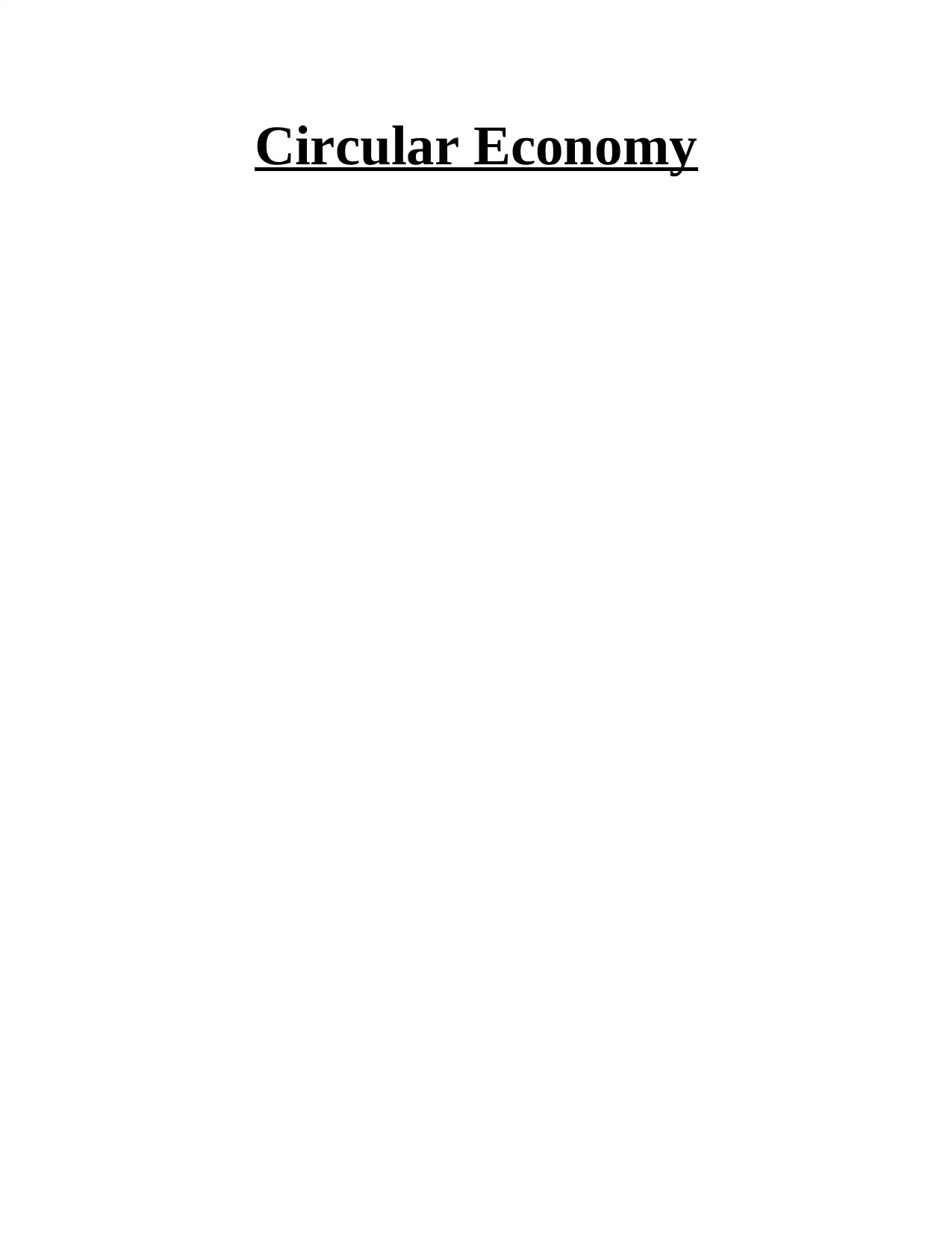
Circular Economy
Paraphrase This Document
Need a fresh take? Get an instant paraphrase of this document with our AI Paraphraser
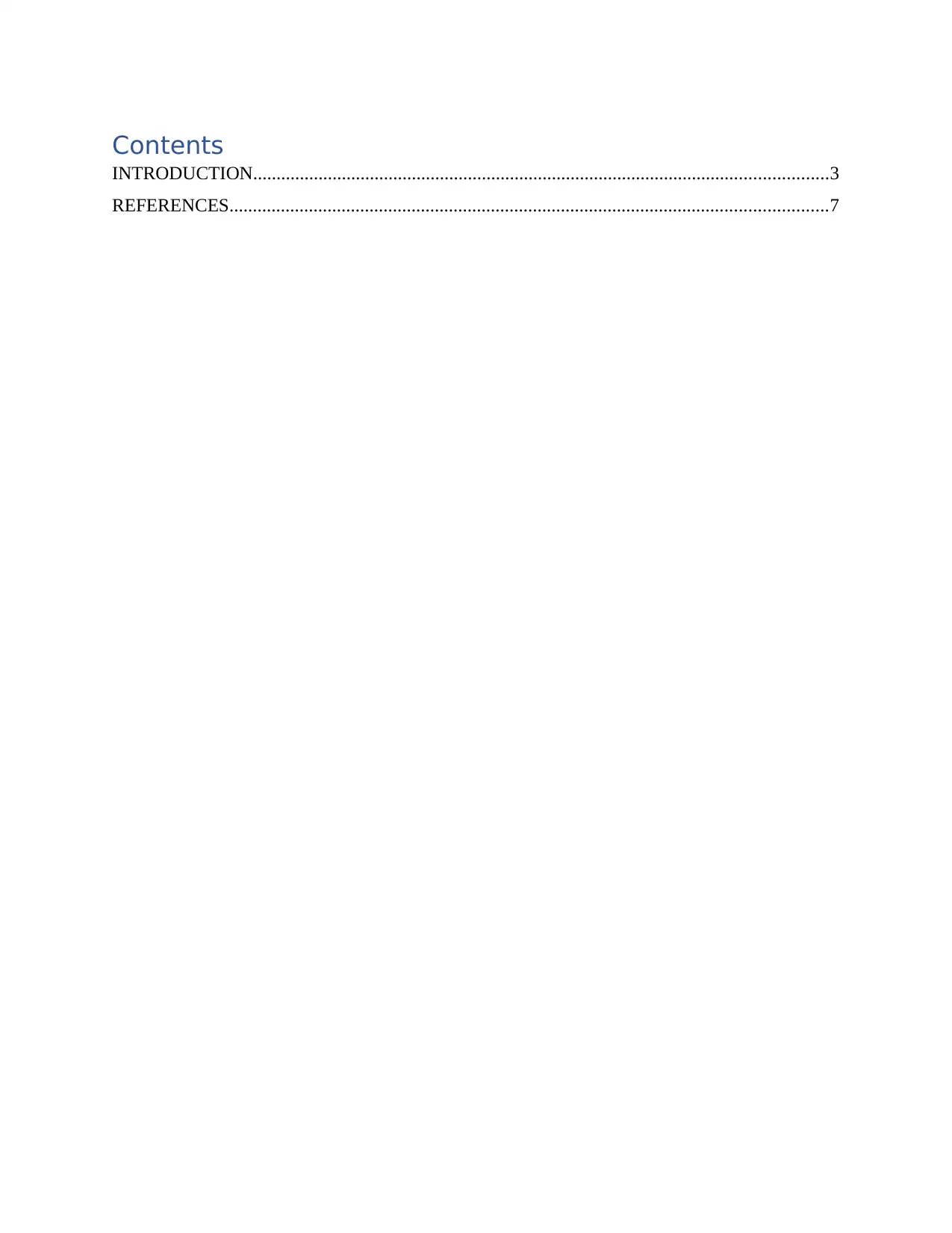
Contents
INTRODUCTION...........................................................................................................................3
REFERENCES................................................................................................................................7
INTRODUCTION...........................................................................................................................3
REFERENCES................................................................................................................................7
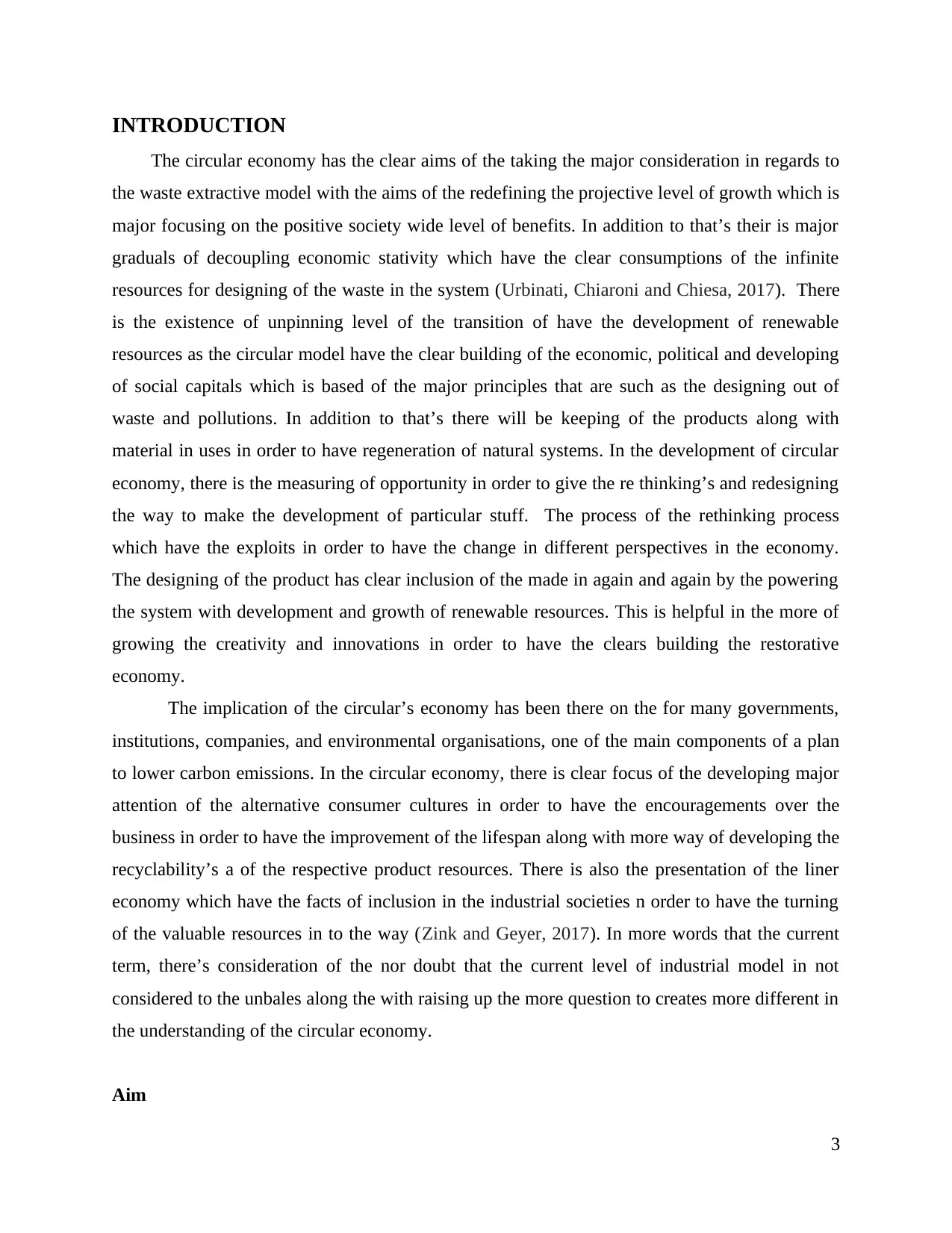
INTRODUCTION
The circular economy has the clear aims of the taking the major consideration in regards to
the waste extractive model with the aims of the redefining the projective level of growth which is
major focusing on the positive society wide level of benefits. In addition to that’s their is major
graduals of decoupling economic stativity which have the clear consumptions of the infinite
resources for designing of the waste in the system (Urbinati, Chiaroni and Chiesa, 2017). There
is the existence of unpinning level of the transition of have the development of renewable
resources as the circular model have the clear building of the economic, political and developing
of social capitals which is based of the major principles that are such as the designing out of
waste and pollutions. In addition to that’s there will be keeping of the products along with
material in uses in order to have regeneration of natural systems. In the development of circular
economy, there is the measuring of opportunity in order to give the re thinking’s and redesigning
the way to make the development of particular stuff. The process of the rethinking process
which have the exploits in order to have the change in different perspectives in the economy.
The designing of the product has clear inclusion of the made in again and again by the powering
the system with development and growth of renewable resources. This is helpful in the more of
growing the creativity and innovations in order to have the clears building the restorative
economy.
The implication of the circular’s economy has been there on the for many governments,
institutions, companies, and environmental organisations, one of the main components of a plan
to lower carbon emissions. In the circular economy, there is clear focus of the developing major
attention of the alternative consumer cultures in order to have the encouragements over the
business in order to have the improvement of the lifespan along with more way of developing the
recyclability’s a of the respective product resources. There is also the presentation of the liner
economy which have the facts of inclusion in the industrial societies n order to have the turning
of the valuable resources in to the way (Zink and Geyer, 2017). In more words that the current
term, there’s consideration of the nor doubt that the current level of industrial model in not
considered to the unbales along the with raising up the more question to creates more different in
the understanding of the circular economy.
Aim
3
The circular economy has the clear aims of the taking the major consideration in regards to
the waste extractive model with the aims of the redefining the projective level of growth which is
major focusing on the positive society wide level of benefits. In addition to that’s their is major
graduals of decoupling economic stativity which have the clear consumptions of the infinite
resources for designing of the waste in the system (Urbinati, Chiaroni and Chiesa, 2017). There
is the existence of unpinning level of the transition of have the development of renewable
resources as the circular model have the clear building of the economic, political and developing
of social capitals which is based of the major principles that are such as the designing out of
waste and pollutions. In addition to that’s there will be keeping of the products along with
material in uses in order to have regeneration of natural systems. In the development of circular
economy, there is the measuring of opportunity in order to give the re thinking’s and redesigning
the way to make the development of particular stuff. The process of the rethinking process
which have the exploits in order to have the change in different perspectives in the economy.
The designing of the product has clear inclusion of the made in again and again by the powering
the system with development and growth of renewable resources. This is helpful in the more of
growing the creativity and innovations in order to have the clears building the restorative
economy.
The implication of the circular’s economy has been there on the for many governments,
institutions, companies, and environmental organisations, one of the main components of a plan
to lower carbon emissions. In the circular economy, there is clear focus of the developing major
attention of the alternative consumer cultures in order to have the encouragements over the
business in order to have the improvement of the lifespan along with more way of developing the
recyclability’s a of the respective product resources. There is also the presentation of the liner
economy which have the facts of inclusion in the industrial societies n order to have the turning
of the valuable resources in to the way (Zink and Geyer, 2017). In more words that the current
term, there’s consideration of the nor doubt that the current level of industrial model in not
considered to the unbales along the with raising up the more question to creates more different in
the understanding of the circular economy.
Aim
3
⊘ This is a preview!⊘
Do you want full access?
Subscribe today to unlock all pages.

Trusted by 1+ million students worldwide
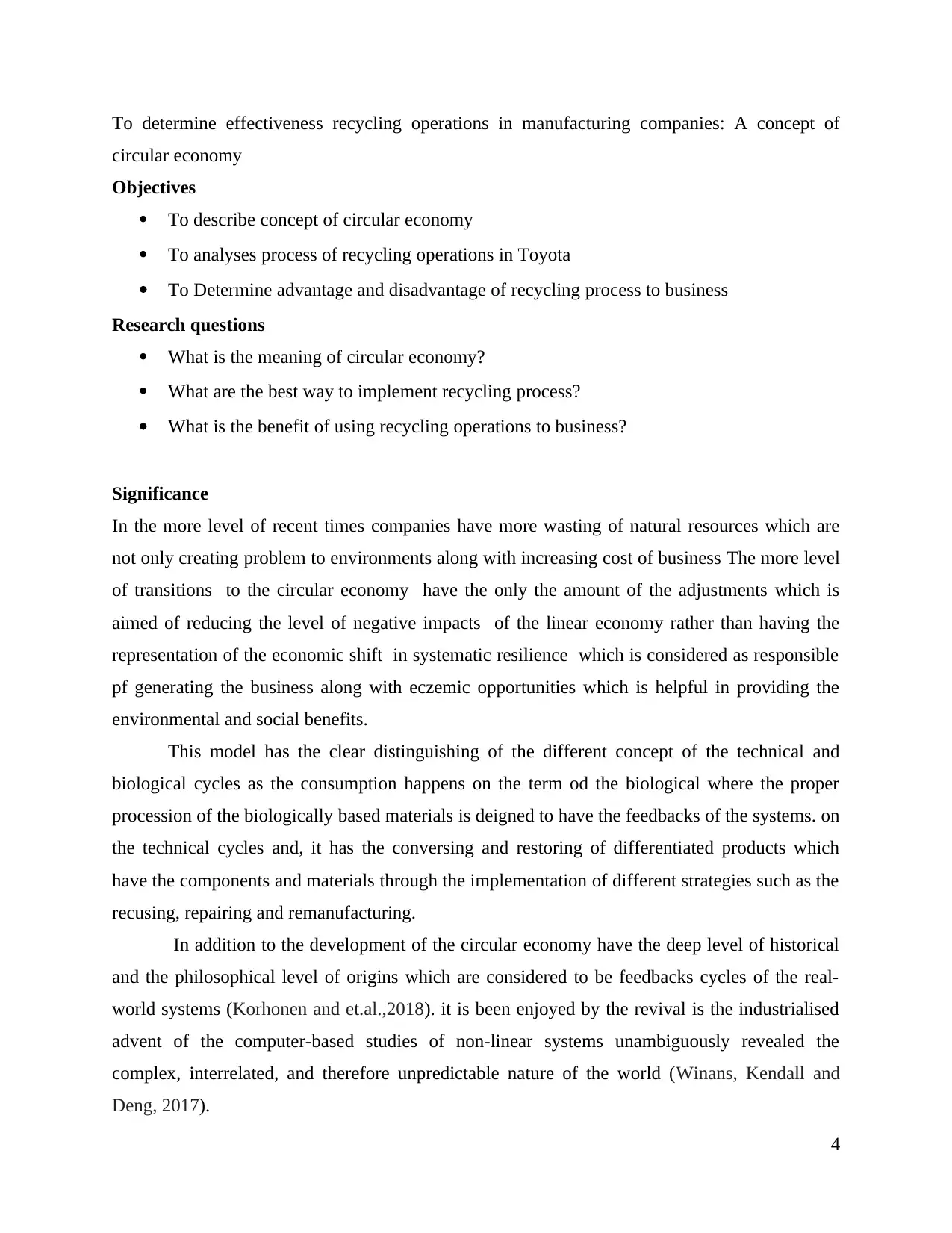
To determine effectiveness recycling operations in manufacturing companies: A concept of
circular economy
Objectives
To describe concept of circular economy
To analyses process of recycling operations in Toyota
To Determine advantage and disadvantage of recycling process to business
Research questions
What is the meaning of circular economy?
What are the best way to implement recycling process?
What is the benefit of using recycling operations to business?
Significance
In the more level of recent times companies have more wasting of natural resources which are
not only creating problem to environments along with increasing cost of business The more level
of transitions to the circular economy have the only the amount of the adjustments which is
aimed of reducing the level of negative impacts of the linear economy rather than having the
representation of the economic shift in systematic resilience which is considered as responsible
pf generating the business along with eczemic opportunities which is helpful in providing the
environmental and social benefits.
This model has the clear distinguishing of the different concept of the technical and
biological cycles as the consumption happens on the term od the biological where the proper
procession of the biologically based materials is deigned to have the feedbacks of the systems. on
the technical cycles and, it has the conversing and restoring of differentiated products which
have the components and materials through the implementation of different strategies such as the
recusing, repairing and remanufacturing.
In addition to the development of the circular economy have the deep level of historical
and the philosophical level of origins which are considered to be feedbacks cycles of the real-
world systems (Korhonen and et.al.,2018). it is been enjoyed by the revival is the industrialised
advent of the computer-based studies of non-linear systems unambiguously revealed the
complex, interrelated, and therefore unpredictable nature of the world (Winans, Kendall and
Deng, 2017).
4
circular economy
Objectives
To describe concept of circular economy
To analyses process of recycling operations in Toyota
To Determine advantage and disadvantage of recycling process to business
Research questions
What is the meaning of circular economy?
What are the best way to implement recycling process?
What is the benefit of using recycling operations to business?
Significance
In the more level of recent times companies have more wasting of natural resources which are
not only creating problem to environments along with increasing cost of business The more level
of transitions to the circular economy have the only the amount of the adjustments which is
aimed of reducing the level of negative impacts of the linear economy rather than having the
representation of the economic shift in systematic resilience which is considered as responsible
pf generating the business along with eczemic opportunities which is helpful in providing the
environmental and social benefits.
This model has the clear distinguishing of the different concept of the technical and
biological cycles as the consumption happens on the term od the biological where the proper
procession of the biologically based materials is deigned to have the feedbacks of the systems. on
the technical cycles and, it has the conversing and restoring of differentiated products which
have the components and materials through the implementation of different strategies such as the
recusing, repairing and remanufacturing.
In addition to the development of the circular economy have the deep level of historical
and the philosophical level of origins which are considered to be feedbacks cycles of the real-
world systems (Korhonen and et.al.,2018). it is been enjoyed by the revival is the industrialised
advent of the computer-based studies of non-linear systems unambiguously revealed the
complex, interrelated, and therefore unpredictable nature of the world (Winans, Kendall and
Deng, 2017).
4
Paraphrase This Document
Need a fresh take? Get an instant paraphrase of this document with our AI Paraphraser
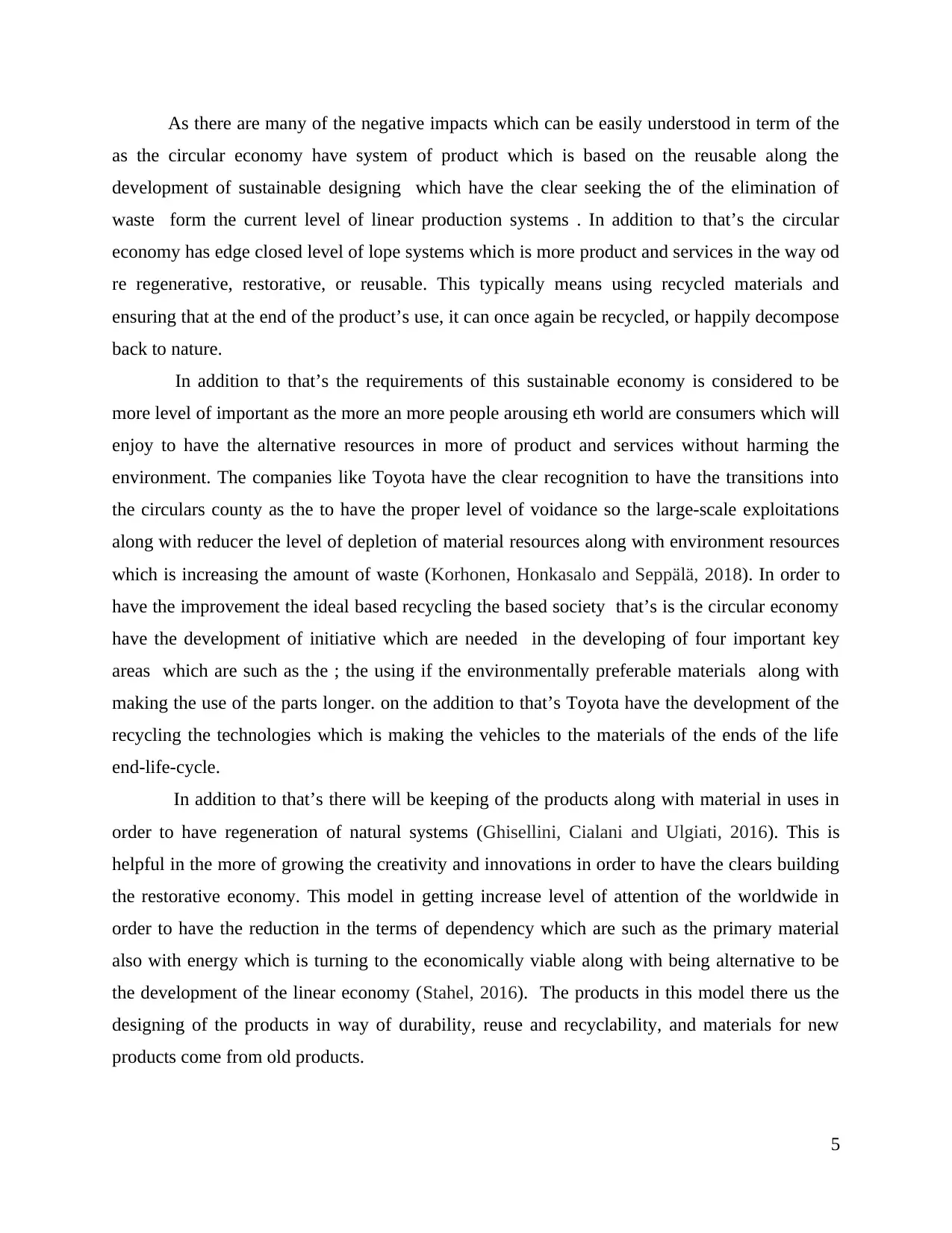
As there are many of the negative impacts which can be easily understood in term of the
as the circular economy have system of product which is based on the reusable along the
development of sustainable designing which have the clear seeking the of the elimination of
waste form the current level of linear production systems . In addition to that’s the circular
economy has edge closed level of lope systems which is more product and services in the way od
re regenerative, restorative, or reusable. This typically means using recycled materials and
ensuring that at the end of the product’s use, it can once again be recycled, or happily decompose
back to nature.
In addition to that’s the requirements of this sustainable economy is considered to be
more level of important as the more an more people arousing eth world are consumers which will
enjoy to have the alternative resources in more of product and services without harming the
environment. The companies like Toyota have the clear recognition to have the transitions into
the circulars county as the to have the proper level of voidance so the large-scale exploitations
along with reducer the level of depletion of material resources along with environment resources
which is increasing the amount of waste (Korhonen, Honkasalo and Seppälä, 2018). In order to
have the improvement the ideal based recycling the based society that’s is the circular economy
have the development of initiative which are needed in the developing of four important key
areas which are such as the ; the using if the environmentally preferable materials along with
making the use of the parts longer. on the addition to that’s Toyota have the development of the
recycling the technologies which is making the vehicles to the materials of the ends of the life
end-life-cycle.
In addition to that’s there will be keeping of the products along with material in uses in
order to have regeneration of natural systems (Ghisellini, Cialani and Ulgiati, 2016). This is
helpful in the more of growing the creativity and innovations in order to have the clears building
the restorative economy. This model in getting increase level of attention of the worldwide in
order to have the reduction in the terms of dependency which are such as the primary material
also with energy which is turning to the economically viable along with being alternative to be
the development of the linear economy (Stahel, 2016). The products in this model there us the
designing of the products in way of durability, reuse and recyclability, and materials for new
products come from old products.
5
as the circular economy have system of product which is based on the reusable along the
development of sustainable designing which have the clear seeking the of the elimination of
waste form the current level of linear production systems . In addition to that’s the circular
economy has edge closed level of lope systems which is more product and services in the way od
re regenerative, restorative, or reusable. This typically means using recycled materials and
ensuring that at the end of the product’s use, it can once again be recycled, or happily decompose
back to nature.
In addition to that’s the requirements of this sustainable economy is considered to be
more level of important as the more an more people arousing eth world are consumers which will
enjoy to have the alternative resources in more of product and services without harming the
environment. The companies like Toyota have the clear recognition to have the transitions into
the circulars county as the to have the proper level of voidance so the large-scale exploitations
along with reducer the level of depletion of material resources along with environment resources
which is increasing the amount of waste (Korhonen, Honkasalo and Seppälä, 2018). In order to
have the improvement the ideal based recycling the based society that’s is the circular economy
have the development of initiative which are needed in the developing of four important key
areas which are such as the ; the using if the environmentally preferable materials along with
making the use of the parts longer. on the addition to that’s Toyota have the development of the
recycling the technologies which is making the vehicles to the materials of the ends of the life
end-life-cycle.
In addition to that’s there will be keeping of the products along with material in uses in
order to have regeneration of natural systems (Ghisellini, Cialani and Ulgiati, 2016). This is
helpful in the more of growing the creativity and innovations in order to have the clears building
the restorative economy. This model in getting increase level of attention of the worldwide in
order to have the reduction in the terms of dependency which are such as the primary material
also with energy which is turning to the economically viable along with being alternative to be
the development of the linear economy (Stahel, 2016). The products in this model there us the
designing of the products in way of durability, reuse and recyclability, and materials for new
products come from old products.
5
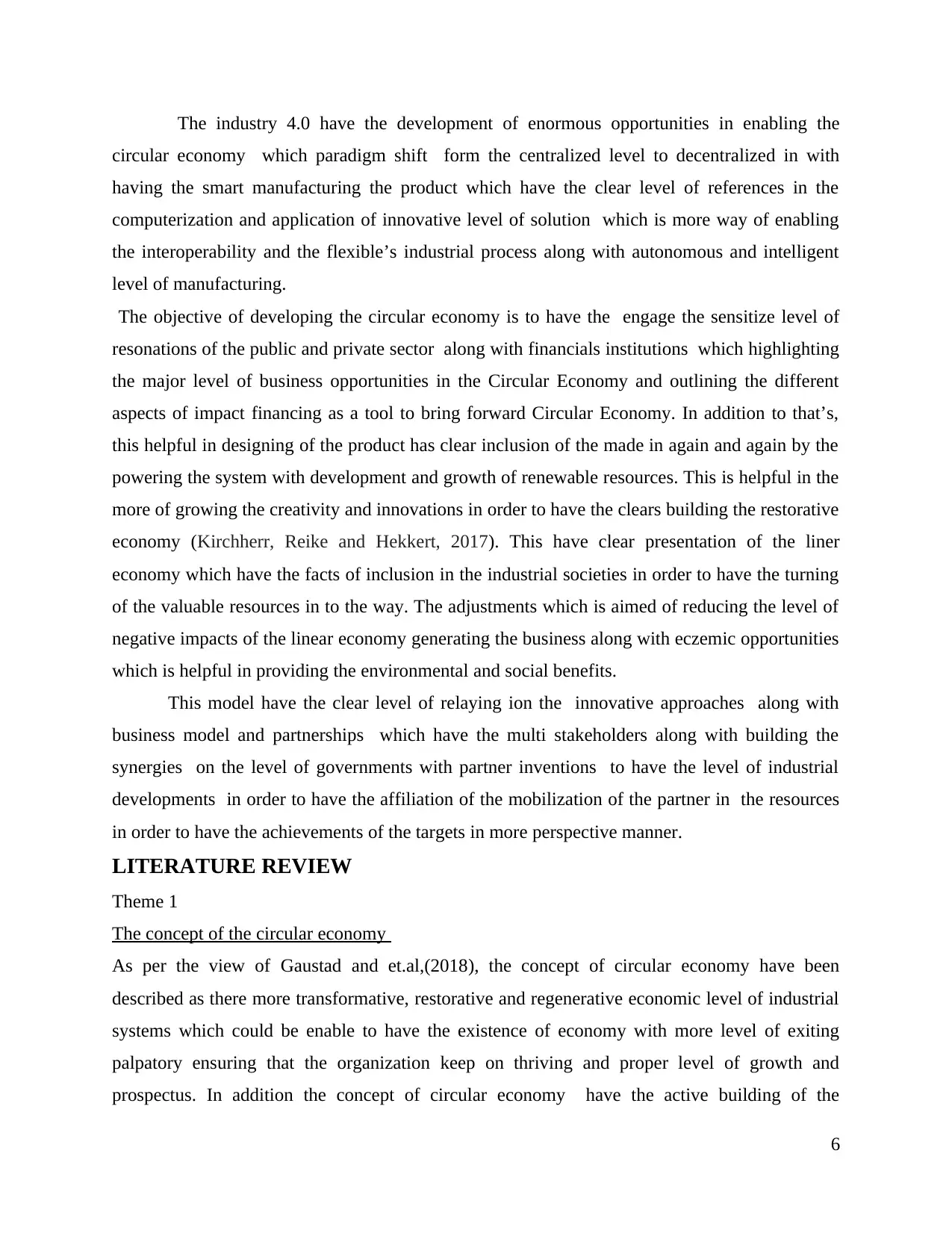
The industry 4.0 have the development of enormous opportunities in enabling the
circular economy which paradigm shift form the centralized level to decentralized in with
having the smart manufacturing the product which have the clear level of references in the
computerization and application of innovative level of solution which is more way of enabling
the interoperability and the flexible’s industrial process along with autonomous and intelligent
level of manufacturing.
The objective of developing the circular economy is to have the engage the sensitize level of
resonations of the public and private sector along with financials institutions which highlighting
the major level of business opportunities in the Circular Economy and outlining the different
aspects of impact financing as a tool to bring forward Circular Economy. In addition to that’s,
this helpful in designing of the product has clear inclusion of the made in again and again by the
powering the system with development and growth of renewable resources. This is helpful in the
more of growing the creativity and innovations in order to have the clears building the restorative
economy (Kirchherr, Reike and Hekkert, 2017). This have clear presentation of the liner
economy which have the facts of inclusion in the industrial societies in order to have the turning
of the valuable resources in to the way. The adjustments which is aimed of reducing the level of
negative impacts of the linear economy generating the business along with eczemic opportunities
which is helpful in providing the environmental and social benefits.
This model have the clear level of relaying ion the innovative approaches along with
business model and partnerships which have the multi stakeholders along with building the
synergies on the level of governments with partner inventions to have the level of industrial
developments in order to have the affiliation of the mobilization of the partner in the resources
in order to have the achievements of the targets in more perspective manner.
LITERATURE REVIEW
Theme 1
The concept of the circular economy
As per the view of Gaustad and et.al,(2018), the concept of circular economy have been
described as there more transformative, restorative and regenerative economic level of industrial
systems which could be enable to have the existence of economy with more level of exiting
palpatory ensuring that the organization keep on thriving and proper level of growth and
prospectus. In addition the concept of circular economy have the active building of the
6
circular economy which paradigm shift form the centralized level to decentralized in with
having the smart manufacturing the product which have the clear level of references in the
computerization and application of innovative level of solution which is more way of enabling
the interoperability and the flexible’s industrial process along with autonomous and intelligent
level of manufacturing.
The objective of developing the circular economy is to have the engage the sensitize level of
resonations of the public and private sector along with financials institutions which highlighting
the major level of business opportunities in the Circular Economy and outlining the different
aspects of impact financing as a tool to bring forward Circular Economy. In addition to that’s,
this helpful in designing of the product has clear inclusion of the made in again and again by the
powering the system with development and growth of renewable resources. This is helpful in the
more of growing the creativity and innovations in order to have the clears building the restorative
economy (Kirchherr, Reike and Hekkert, 2017). This have clear presentation of the liner
economy which have the facts of inclusion in the industrial societies in order to have the turning
of the valuable resources in to the way. The adjustments which is aimed of reducing the level of
negative impacts of the linear economy generating the business along with eczemic opportunities
which is helpful in providing the environmental and social benefits.
This model have the clear level of relaying ion the innovative approaches along with
business model and partnerships which have the multi stakeholders along with building the
synergies on the level of governments with partner inventions to have the level of industrial
developments in order to have the affiliation of the mobilization of the partner in the resources
in order to have the achievements of the targets in more perspective manner.
LITERATURE REVIEW
Theme 1
The concept of the circular economy
As per the view of Gaustad and et.al,(2018), the concept of circular economy have been
described as there more transformative, restorative and regenerative economic level of industrial
systems which could be enable to have the existence of economy with more level of exiting
palpatory ensuring that the organization keep on thriving and proper level of growth and
prospectus. In addition the concept of circular economy have the active building of the
6
⊘ This is a preview!⊘
Do you want full access?
Subscribe today to unlock all pages.

Trusted by 1+ million students worldwide
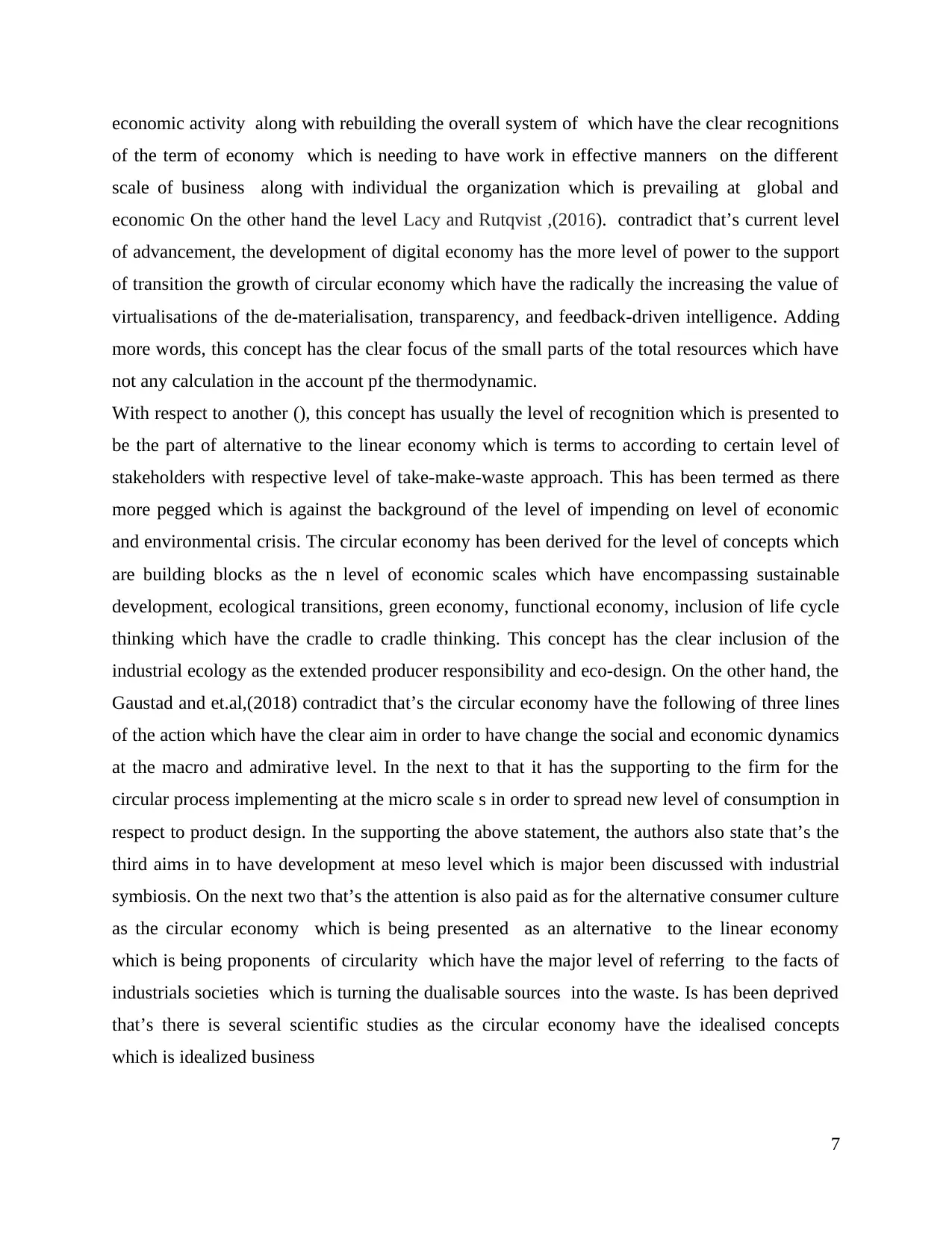
economic activity along with rebuilding the overall system of which have the clear recognitions
of the term of economy which is needing to have work in effective manners on the different
scale of business along with individual the organization which is prevailing at global and
economic On the other hand the level Lacy and Rutqvist ,(2016). contradict that’s current level
of advancement, the development of digital economy has the more level of power to the support
of transition the growth of circular economy which have the radically the increasing the value of
virtualisations of the de-materialisation, transparency, and feedback-driven intelligence. Adding
more words, this concept has the clear focus of the small parts of the total resources which have
not any calculation in the account pf the thermodynamic.
With respect to another (), this concept has usually the level of recognition which is presented to
be the part of alternative to the linear economy which is terms to according to certain level of
stakeholders with respective level of take-make-waste approach. This has been termed as there
more pegged which is against the background of the level of impending on level of economic
and environmental crisis. The circular economy has been derived for the level of concepts which
are building blocks as the n level of economic scales which have encompassing sustainable
development, ecological transitions, green economy, functional economy, inclusion of life cycle
thinking which have the cradle to cradle thinking. This concept has the clear inclusion of the
industrial ecology as the extended producer responsibility and eco-design. On the other hand, the
Gaustad and et.al,(2018) contradict that’s the circular economy have the following of three lines
of the action which have the clear aim in order to have change the social and economic dynamics
at the macro and admirative level. In the next to that it has the supporting to the firm for the
circular process implementing at the micro scale s in order to spread new level of consumption in
respect to product design. In the supporting the above statement, the authors also state that’s the
third aims in to have development at meso level which is major been discussed with industrial
symbiosis. On the next two that’s the attention is also paid as for the alternative consumer culture
as the circular economy which is being presented as an alternative to the linear economy
which is being proponents of circularity which have the major level of referring to the facts of
industrials societies which is turning the dualisable sources into the waste. Is has been deprived
that’s there is several scientific studies as the circular economy have the idealised concepts
which is idealized business
7
of the term of economy which is needing to have work in effective manners on the different
scale of business along with individual the organization which is prevailing at global and
economic On the other hand the level Lacy and Rutqvist ,(2016). contradict that’s current level
of advancement, the development of digital economy has the more level of power to the support
of transition the growth of circular economy which have the radically the increasing the value of
virtualisations of the de-materialisation, transparency, and feedback-driven intelligence. Adding
more words, this concept has the clear focus of the small parts of the total resources which have
not any calculation in the account pf the thermodynamic.
With respect to another (), this concept has usually the level of recognition which is presented to
be the part of alternative to the linear economy which is terms to according to certain level of
stakeholders with respective level of take-make-waste approach. This has been termed as there
more pegged which is against the background of the level of impending on level of economic
and environmental crisis. The circular economy has been derived for the level of concepts which
are building blocks as the n level of economic scales which have encompassing sustainable
development, ecological transitions, green economy, functional economy, inclusion of life cycle
thinking which have the cradle to cradle thinking. This concept has the clear inclusion of the
industrial ecology as the extended producer responsibility and eco-design. On the other hand, the
Gaustad and et.al,(2018) contradict that’s the circular economy have the following of three lines
of the action which have the clear aim in order to have change the social and economic dynamics
at the macro and admirative level. In the next to that it has the supporting to the firm for the
circular process implementing at the micro scale s in order to spread new level of consumption in
respect to product design. In the supporting the above statement, the authors also state that’s the
third aims in to have development at meso level which is major been discussed with industrial
symbiosis. On the next two that’s the attention is also paid as for the alternative consumer culture
as the circular economy which is being presented as an alternative to the linear economy
which is being proponents of circularity which have the major level of referring to the facts of
industrials societies which is turning the dualisable sources into the waste. Is has been deprived
that’s there is several scientific studies as the circular economy have the idealised concepts
which is idealized business
7
Paraphrase This Document
Need a fresh take? Get an instant paraphrase of this document with our AI Paraphraser
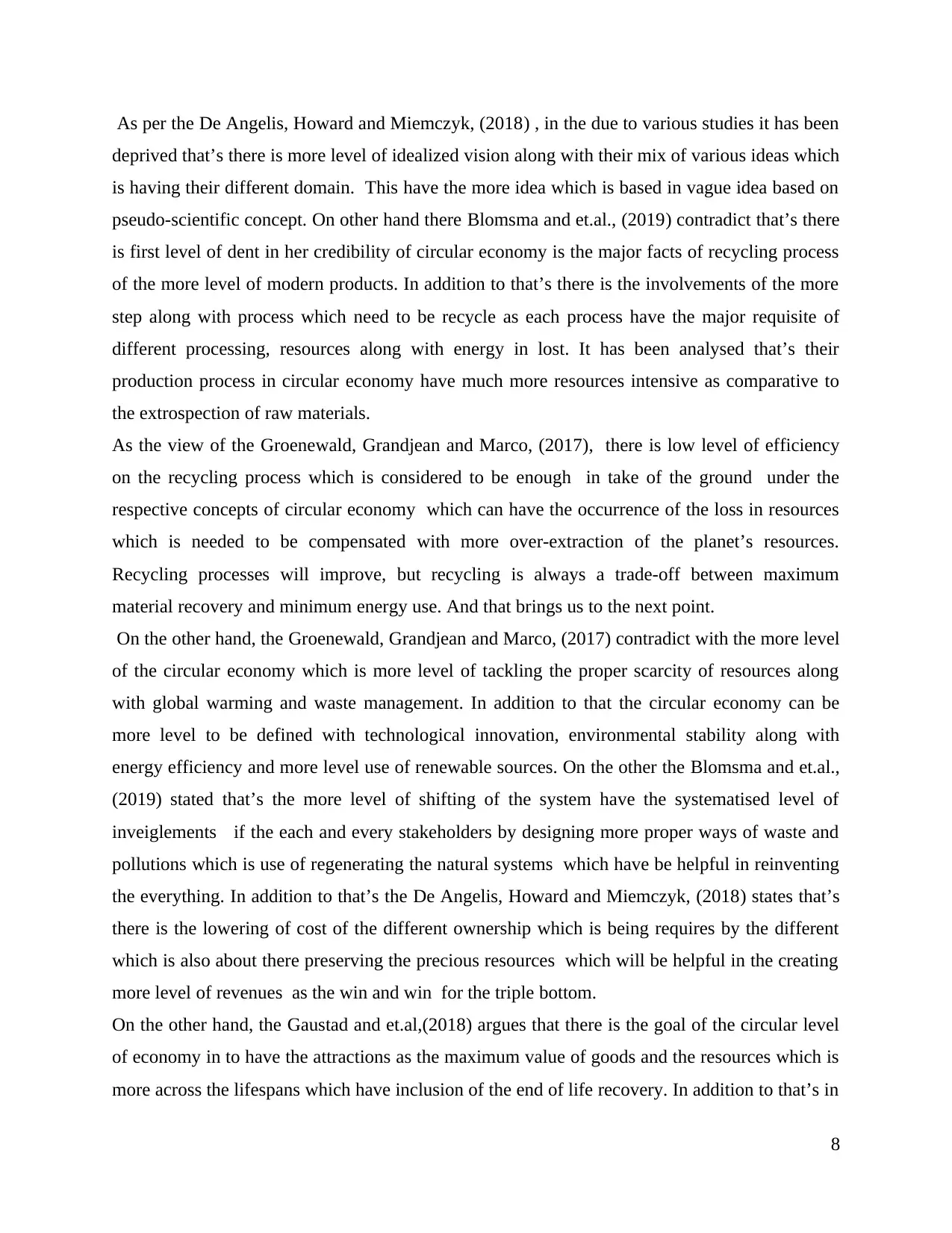
As per the De Angelis, Howard and Miemczyk, (2018) , in the due to various studies it has been
deprived that’s there is more level of idealized vision along with their mix of various ideas which
is having their different domain. This have the more idea which is based in vague idea based on
pseudo-scientific concept. On other hand there Blomsma and et.al., (2019) contradict that’s there
is first level of dent in her credibility of circular economy is the major facts of recycling process
of the more level of modern products. In addition to that’s there is the involvements of the more
step along with process which need to be recycle as each process have the major requisite of
different processing, resources along with energy in lost. It has been analysed that’s their
production process in circular economy have much more resources intensive as comparative to
the extrospection of raw materials.
As the view of the Groenewald, Grandjean and Marco, (2017), there is low level of efficiency
on the recycling process which is considered to be enough in take of the ground under the
respective concepts of circular economy which can have the occurrence of the loss in resources
which is needed to be compensated with more over-extraction of the planet’s resources.
Recycling processes will improve, but recycling is always a trade-off between maximum
material recovery and minimum energy use. And that brings us to the next point.
On the other hand, the Groenewald, Grandjean and Marco, (2017) contradict with the more level
of the circular economy which is more level of tackling the proper scarcity of resources along
with global warming and waste management. In addition to that the circular economy can be
more level to be defined with technological innovation, environmental stability along with
energy efficiency and more level use of renewable sources. On the other the Blomsma and et.al.,
(2019) stated that’s the more level of shifting of the system have the systematised level of
inveiglements if the each and every stakeholders by designing more proper ways of waste and
pollutions which is use of regenerating the natural systems which have be helpful in reinventing
the everything. In addition to that’s the De Angelis, Howard and Miemczyk, (2018) states that’s
there is the lowering of cost of the different ownership which is being requires by the different
which is also about there preserving the precious resources which will be helpful in the creating
more level of revenues as the win and win for the triple bottom.
On the other hand, the Gaustad and et.al,(2018) argues that there is the goal of the circular level
of economy in to have the attractions as the maximum value of goods and the resources which is
more across the lifespans which have inclusion of the end of life recovery. In addition to that’s in
8
deprived that’s there is more level of idealized vision along with their mix of various ideas which
is having their different domain. This have the more idea which is based in vague idea based on
pseudo-scientific concept. On other hand there Blomsma and et.al., (2019) contradict that’s there
is first level of dent in her credibility of circular economy is the major facts of recycling process
of the more level of modern products. In addition to that’s there is the involvements of the more
step along with process which need to be recycle as each process have the major requisite of
different processing, resources along with energy in lost. It has been analysed that’s their
production process in circular economy have much more resources intensive as comparative to
the extrospection of raw materials.
As the view of the Groenewald, Grandjean and Marco, (2017), there is low level of efficiency
on the recycling process which is considered to be enough in take of the ground under the
respective concepts of circular economy which can have the occurrence of the loss in resources
which is needed to be compensated with more over-extraction of the planet’s resources.
Recycling processes will improve, but recycling is always a trade-off between maximum
material recovery and minimum energy use. And that brings us to the next point.
On the other hand, the Groenewald, Grandjean and Marco, (2017) contradict with the more level
of the circular economy which is more level of tackling the proper scarcity of resources along
with global warming and waste management. In addition to that the circular economy can be
more level to be defined with technological innovation, environmental stability along with
energy efficiency and more level use of renewable sources. On the other the Blomsma and et.al.,
(2019) stated that’s the more level of shifting of the system have the systematised level of
inveiglements if the each and every stakeholders by designing more proper ways of waste and
pollutions which is use of regenerating the natural systems which have be helpful in reinventing
the everything. In addition to that’s the De Angelis, Howard and Miemczyk, (2018) states that’s
there is the lowering of cost of the different ownership which is being requires by the different
which is also about there preserving the precious resources which will be helpful in the creating
more level of revenues as the win and win for the triple bottom.
On the other hand, the Gaustad and et.al,(2018) argues that there is the goal of the circular level
of economy in to have the attractions as the maximum value of goods and the resources which is
more across the lifespans which have inclusion of the end of life recovery. In addition to that’s in
8
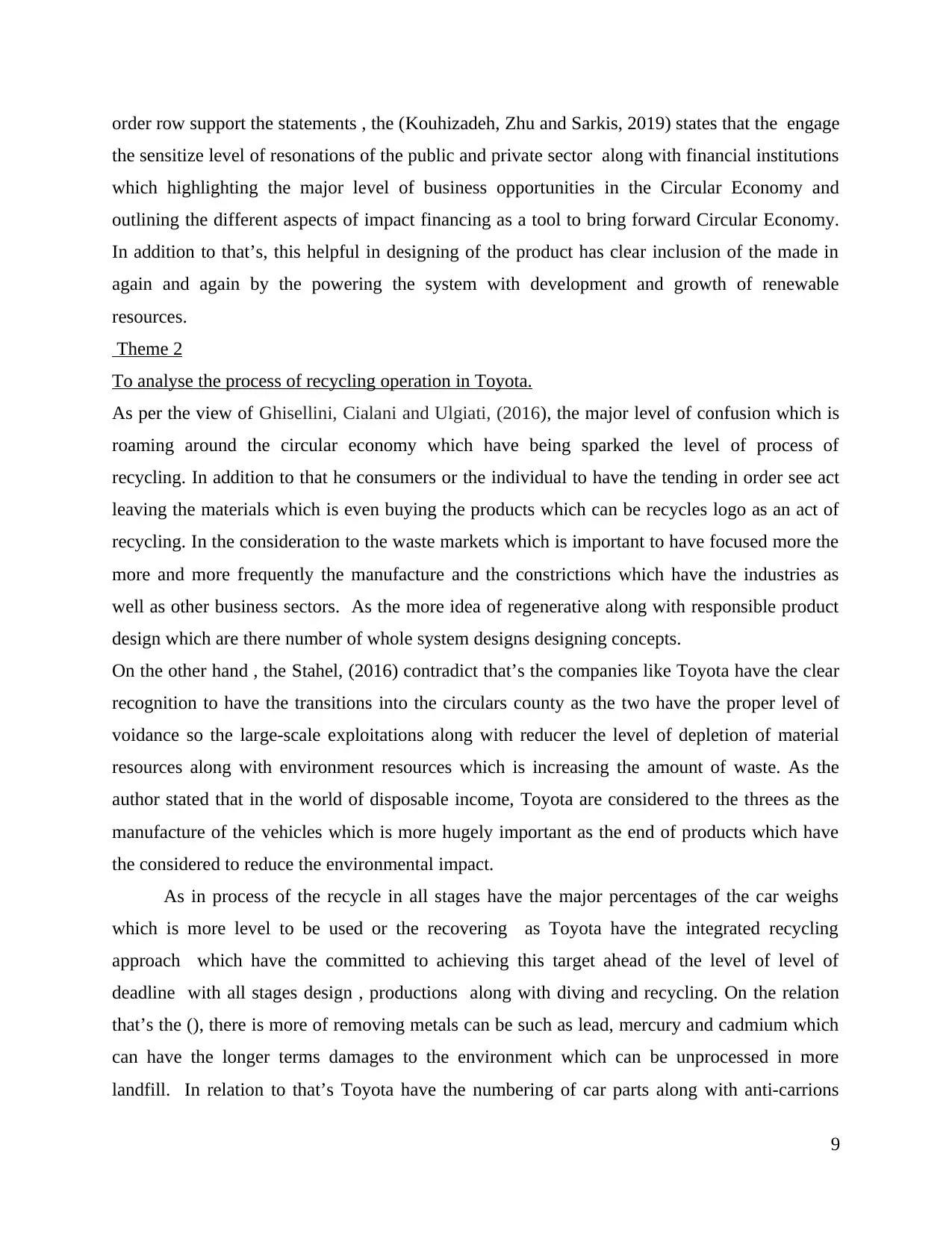
order row support the statements , the (Kouhizadeh, Zhu and Sarkis, 2019) states that the engage
the sensitize level of resonations of the public and private sector along with financial institutions
which highlighting the major level of business opportunities in the Circular Economy and
outlining the different aspects of impact financing as a tool to bring forward Circular Economy.
In addition to that’s, this helpful in designing of the product has clear inclusion of the made in
again and again by the powering the system with development and growth of renewable
resources.
Theme 2
To analyse the process of recycling operation in Toyota.
As per the view of Ghisellini, Cialani and Ulgiati, (2016), the major level of confusion which is
roaming around the circular economy which have being sparked the level of process of
recycling. In addition to that he consumers or the individual to have the tending in order see act
leaving the materials which is even buying the products which can be recycles logo as an act of
recycling. In the consideration to the waste markets which is important to have focused more the
more and more frequently the manufacture and the constrictions which have the industries as
well as other business sectors. As the more idea of regenerative along with responsible product
design which are there number of whole system designs designing concepts.
On the other hand , the Stahel, (2016) contradict that’s the companies like Toyota have the clear
recognition to have the transitions into the circulars county as the two have the proper level of
voidance so the large-scale exploitations along with reducer the level of depletion of material
resources along with environment resources which is increasing the amount of waste. As the
author stated that in the world of disposable income, Toyota are considered to the threes as the
manufacture of the vehicles which is more hugely important as the end of products which have
the considered to reduce the environmental impact.
As in process of the recycle in all stages have the major percentages of the car weighs
which is more level to be used or the recovering as Toyota have the integrated recycling
approach which have the committed to achieving this target ahead of the level of level of
deadline with all stages design , productions along with diving and recycling. On the relation
that’s the (), there is more of removing metals can be such as lead, mercury and cadmium which
can have the longer terms damages to the environment which can be unprocessed in more
landfill. In relation to that’s Toyota have the numbering of car parts along with anti-carrions
9
the sensitize level of resonations of the public and private sector along with financial institutions
which highlighting the major level of business opportunities in the Circular Economy and
outlining the different aspects of impact financing as a tool to bring forward Circular Economy.
In addition to that’s, this helpful in designing of the product has clear inclusion of the made in
again and again by the powering the system with development and growth of renewable
resources.
Theme 2
To analyse the process of recycling operation in Toyota.
As per the view of Ghisellini, Cialani and Ulgiati, (2016), the major level of confusion which is
roaming around the circular economy which have being sparked the level of process of
recycling. In addition to that he consumers or the individual to have the tending in order see act
leaving the materials which is even buying the products which can be recycles logo as an act of
recycling. In the consideration to the waste markets which is important to have focused more the
more and more frequently the manufacture and the constrictions which have the industries as
well as other business sectors. As the more idea of regenerative along with responsible product
design which are there number of whole system designs designing concepts.
On the other hand , the Stahel, (2016) contradict that’s the companies like Toyota have the clear
recognition to have the transitions into the circulars county as the two have the proper level of
voidance so the large-scale exploitations along with reducer the level of depletion of material
resources along with environment resources which is increasing the amount of waste. As the
author stated that in the world of disposable income, Toyota are considered to the threes as the
manufacture of the vehicles which is more hugely important as the end of products which have
the considered to reduce the environmental impact.
As in process of the recycle in all stages have the major percentages of the car weighs
which is more level to be used or the recovering as Toyota have the integrated recycling
approach which have the committed to achieving this target ahead of the level of level of
deadline with all stages design , productions along with diving and recycling. On the relation
that’s the (), there is more of removing metals can be such as lead, mercury and cadmium which
can have the longer terms damages to the environment which can be unprocessed in more
landfill. In relation to that’s Toyota have the numbering of car parts along with anti-carrions
9
⊘ This is a preview!⊘
Do you want full access?
Subscribe today to unlock all pages.

Trusted by 1+ million students worldwide
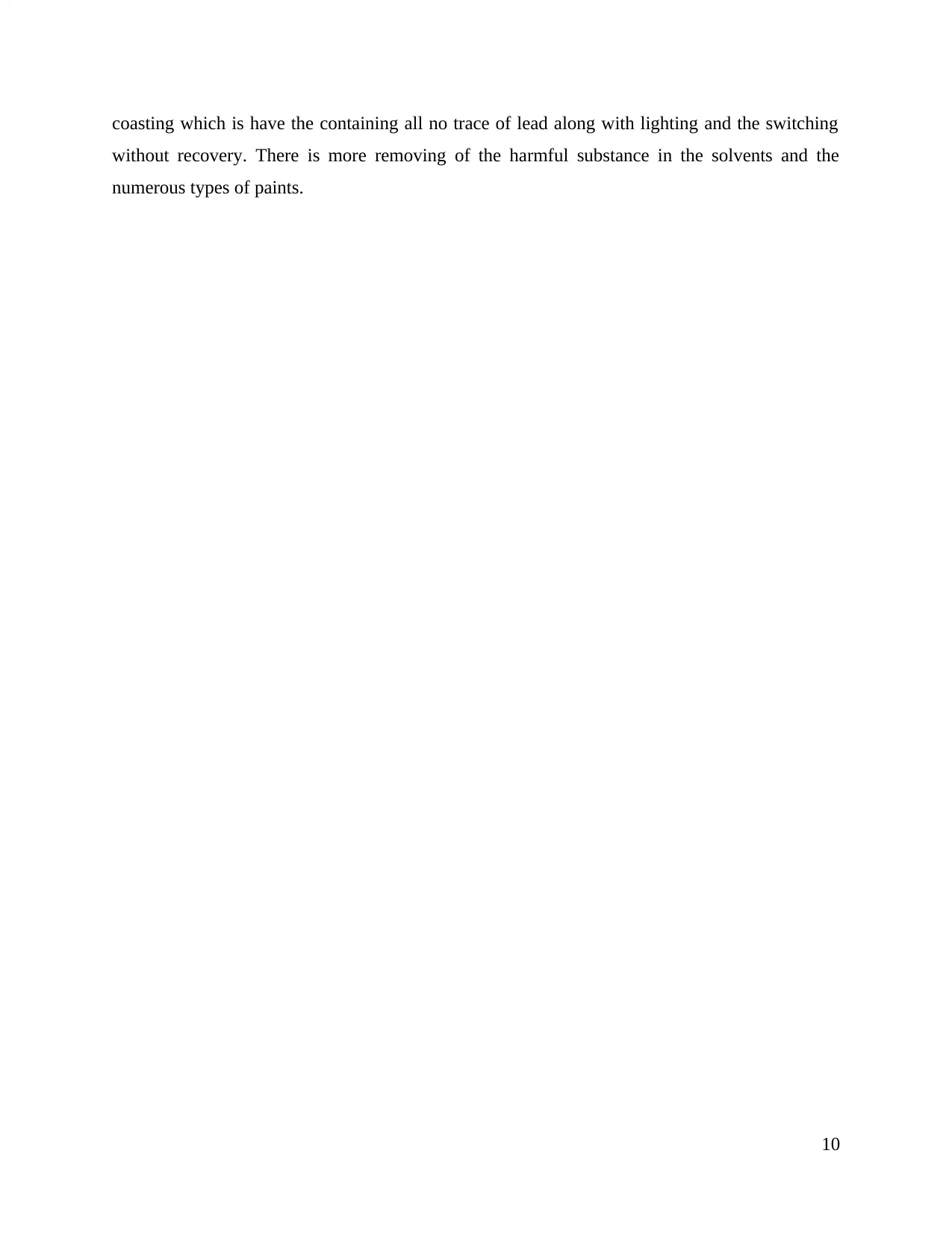
coasting which is have the containing all no trace of lead along with lighting and the switching
without recovery. There is more removing of the harmful substance in the solvents and the
numerous types of paints.
10
without recovery. There is more removing of the harmful substance in the solvents and the
numerous types of paints.
10
Paraphrase This Document
Need a fresh take? Get an instant paraphrase of this document with our AI Paraphraser
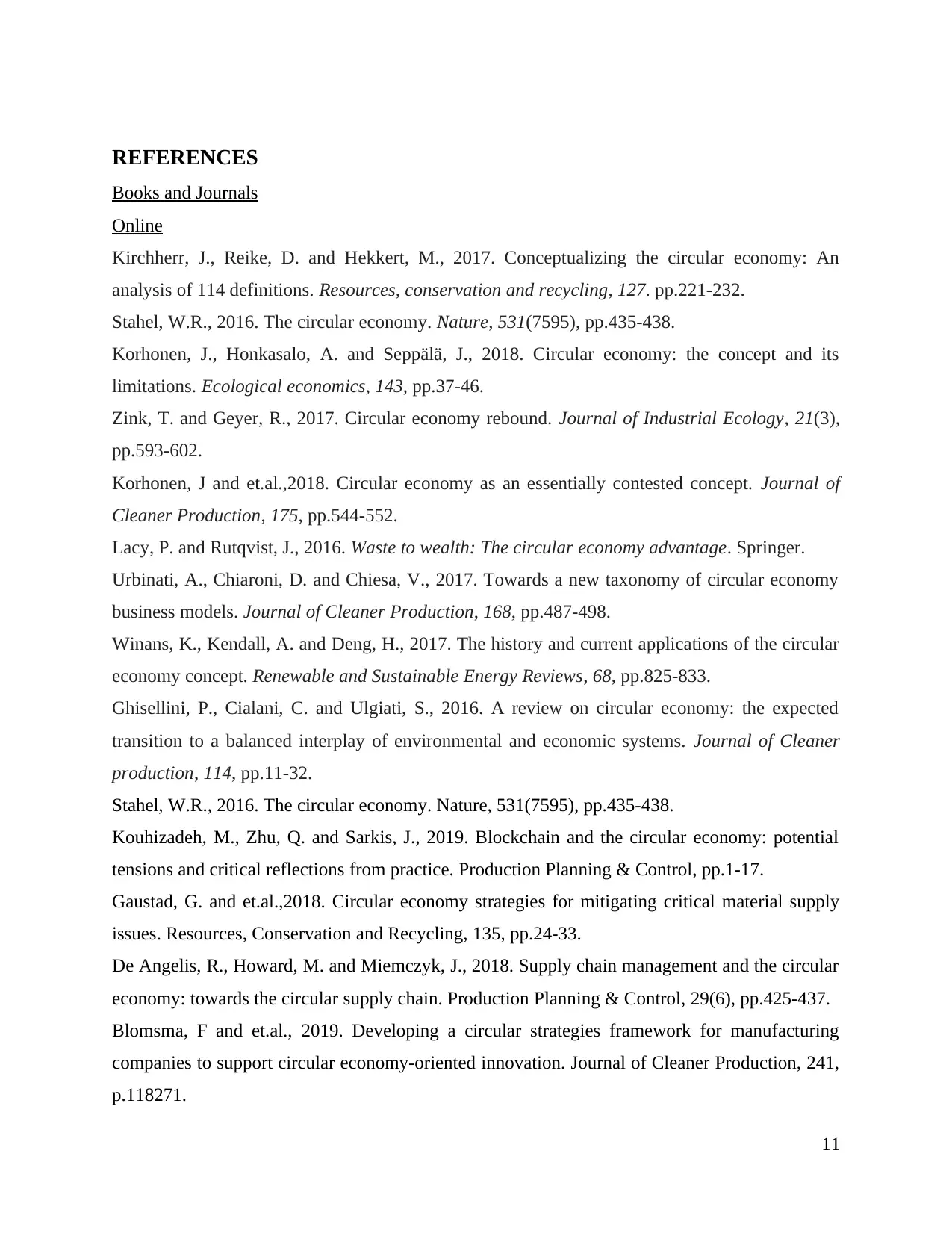
REFERENCES
Books and Journals
Online
Kirchherr, J., Reike, D. and Hekkert, M., 2017. Conceptualizing the circular economy: An
analysis of 114 definitions. Resources, conservation and recycling, 127. pp.221-232.
Stahel, W.R., 2016. The circular economy. Nature, 531(7595), pp.435-438.
Korhonen, J., Honkasalo, A. and Seppälä, J., 2018. Circular economy: the concept and its
limitations. Ecological economics, 143, pp.37-46.
Zink, T. and Geyer, R., 2017. Circular economy rebound. Journal of Industrial Ecology, 21(3),
pp.593-602.
Korhonen, J and et.al.,2018. Circular economy as an essentially contested concept. Journal of
Cleaner Production, 175, pp.544-552.
Lacy, P. and Rutqvist, J., 2016. Waste to wealth: The circular economy advantage. Springer.
Urbinati, A., Chiaroni, D. and Chiesa, V., 2017. Towards a new taxonomy of circular economy
business models. Journal of Cleaner Production, 168, pp.487-498.
Winans, K., Kendall, A. and Deng, H., 2017. The history and current applications of the circular
economy concept. Renewable and Sustainable Energy Reviews, 68, pp.825-833.
Ghisellini, P., Cialani, C. and Ulgiati, S., 2016. A review on circular economy: the expected
transition to a balanced interplay of environmental and economic systems. Journal of Cleaner
production, 114, pp.11-32.
Stahel, W.R., 2016. The circular economy. Nature, 531(7595), pp.435-438.
Kouhizadeh, M., Zhu, Q. and Sarkis, J., 2019. Blockchain and the circular economy: potential
tensions and critical reflections from practice. Production Planning & Control, pp.1-17.
Gaustad, G. and et.al.,2018. Circular economy strategies for mitigating critical material supply
issues. Resources, Conservation and Recycling, 135, pp.24-33.
De Angelis, R., Howard, M. and Miemczyk, J., 2018. Supply chain management and the circular
economy: towards the circular supply chain. Production Planning & Control, 29(6), pp.425-437.
Blomsma, F and et.al., 2019. Developing a circular strategies framework for manufacturing
companies to support circular economy-oriented innovation. Journal of Cleaner Production, 241,
p.118271.
11
Books and Journals
Online
Kirchherr, J., Reike, D. and Hekkert, M., 2017. Conceptualizing the circular economy: An
analysis of 114 definitions. Resources, conservation and recycling, 127. pp.221-232.
Stahel, W.R., 2016. The circular economy. Nature, 531(7595), pp.435-438.
Korhonen, J., Honkasalo, A. and Seppälä, J., 2018. Circular economy: the concept and its
limitations. Ecological economics, 143, pp.37-46.
Zink, T. and Geyer, R., 2017. Circular economy rebound. Journal of Industrial Ecology, 21(3),
pp.593-602.
Korhonen, J and et.al.,2018. Circular economy as an essentially contested concept. Journal of
Cleaner Production, 175, pp.544-552.
Lacy, P. and Rutqvist, J., 2016. Waste to wealth: The circular economy advantage. Springer.
Urbinati, A., Chiaroni, D. and Chiesa, V., 2017. Towards a new taxonomy of circular economy
business models. Journal of Cleaner Production, 168, pp.487-498.
Winans, K., Kendall, A. and Deng, H., 2017. The history and current applications of the circular
economy concept. Renewable and Sustainable Energy Reviews, 68, pp.825-833.
Ghisellini, P., Cialani, C. and Ulgiati, S., 2016. A review on circular economy: the expected
transition to a balanced interplay of environmental and economic systems. Journal of Cleaner
production, 114, pp.11-32.
Stahel, W.R., 2016. The circular economy. Nature, 531(7595), pp.435-438.
Kouhizadeh, M., Zhu, Q. and Sarkis, J., 2019. Blockchain and the circular economy: potential
tensions and critical reflections from practice. Production Planning & Control, pp.1-17.
Gaustad, G. and et.al.,2018. Circular economy strategies for mitigating critical material supply
issues. Resources, Conservation and Recycling, 135, pp.24-33.
De Angelis, R., Howard, M. and Miemczyk, J., 2018. Supply chain management and the circular
economy: towards the circular supply chain. Production Planning & Control, 29(6), pp.425-437.
Blomsma, F and et.al., 2019. Developing a circular strategies framework for manufacturing
companies to support circular economy-oriented innovation. Journal of Cleaner Production, 241,
p.118271.
11
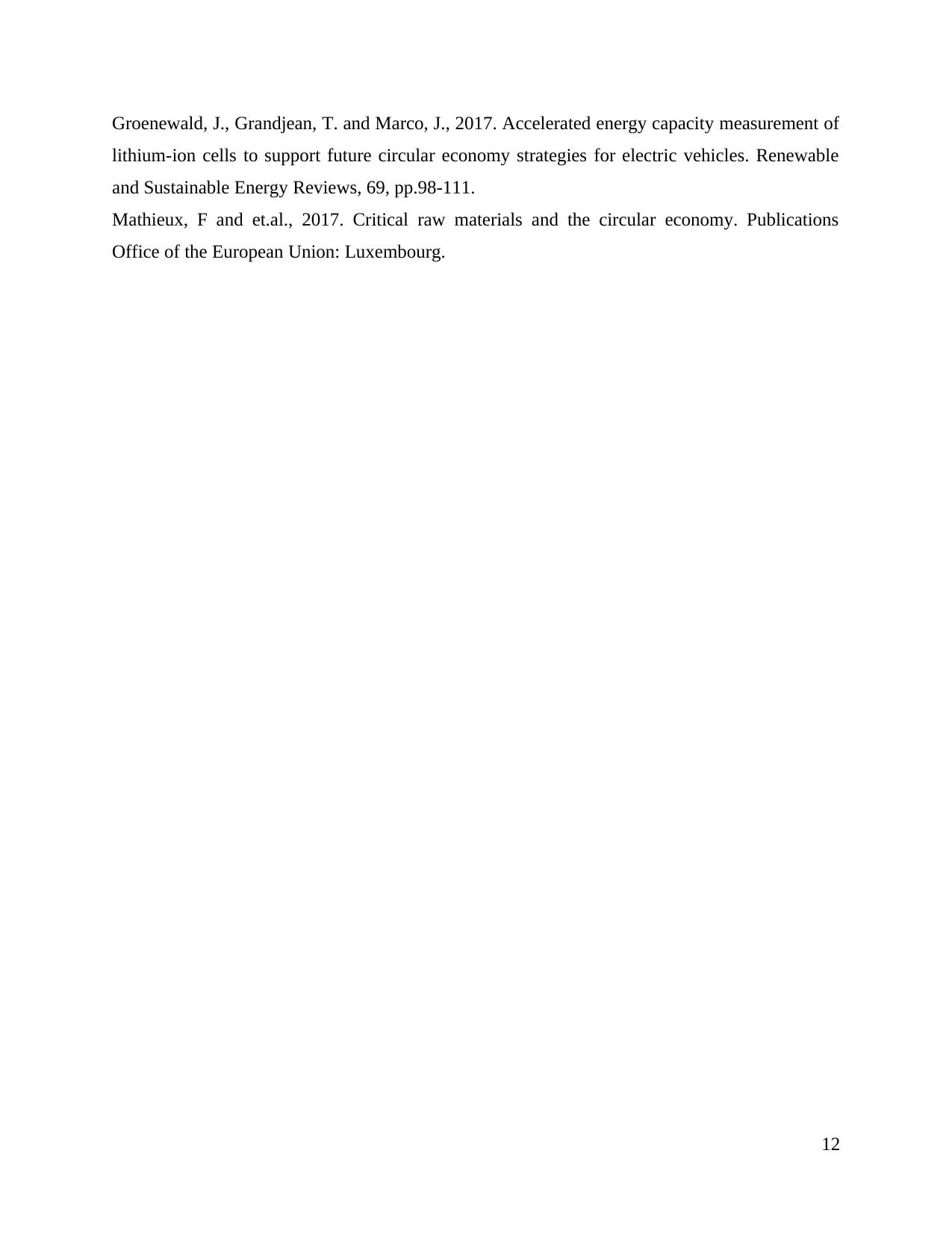
Groenewald, J., Grandjean, T. and Marco, J., 2017. Accelerated energy capacity measurement of
lithium-ion cells to support future circular economy strategies for electric vehicles. Renewable
and Sustainable Energy Reviews, 69, pp.98-111.
Mathieux, F and et.al., 2017. Critical raw materials and the circular economy. Publications
Office of the European Union: Luxembourg.
12
lithium-ion cells to support future circular economy strategies for electric vehicles. Renewable
and Sustainable Energy Reviews, 69, pp.98-111.
Mathieux, F and et.al., 2017. Critical raw materials and the circular economy. Publications
Office of the European Union: Luxembourg.
12
⊘ This is a preview!⊘
Do you want full access?
Subscribe today to unlock all pages.

Trusted by 1+ million students worldwide
1 out of 15
Related Documents
Your All-in-One AI-Powered Toolkit for Academic Success.
+13062052269
info@desklib.com
Available 24*7 on WhatsApp / Email
![[object Object]](/_next/static/media/star-bottom.7253800d.svg)
Unlock your academic potential
Copyright © 2020–2025 A2Z Services. All Rights Reserved. Developed and managed by ZUCOL.





